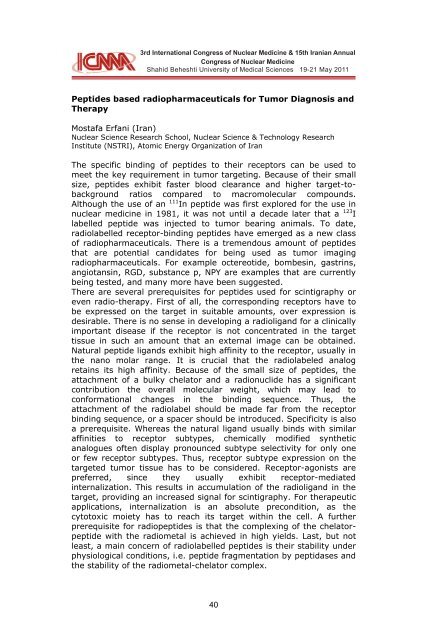Panel Disdussion
Panel Disdussion
Panel Disdussion
You also want an ePaper? Increase the reach of your titles
YUMPU automatically turns print PDFs into web optimized ePapers that Google loves.
3rd International Congress 3rd International of Nuclear Congress Medicine of Nuclear & 15th Medicine Iranian Annual & 15th Iranian Congress Annual of<br />
Nuclear Congress Medicine of Nuclear Medicine<br />
Shahid Beheshti Shahid Beheshti University University of Medical Sciences of Medical 19-21 Sciences May 201119-21 May 2011<br />
Peptides based radiopharmaceuticals for Tumor Diagnosis and<br />
Therapy<br />
Mostafa Erfani (Iran)<br />
Nuclear Science Research School, Nuclear Science & Technology Research<br />
Institute (NSTRI), Atomic Energy Organization of Iran<br />
The specific binding of peptides to their receptors can be used to<br />
meet the key requirement in tumor targeting. Because of their small<br />
size, peptides exhibit faster blood clearance and higher target-tobackground<br />
ratios compared to macromolecular compounds.<br />
Although the use of an 111 In peptide was first explored for the use in<br />
nuclear medicine in 1981, it was not until a decade later that a 123 I<br />
labelled peptide was injected to tumor bearing animals. To date,<br />
radiolabelled receptor-binding peptides have emerged as a new class<br />
of radiopharmaceuticals. There is a tremendous amount of peptides<br />
that are potential candidates for being used as tumor imaging<br />
radiopharmaceuticals. For example octereotide, bombesin, gastrins,<br />
angiotansin, RGD, substance p, NPY are examples that are currently<br />
being tested, and many more have been suggested.<br />
There are several prerequisites for peptides used for scintigraphy or<br />
even radio-therapy. First of all, the corresponding receptors have to<br />
be expressed on the target in suitable amounts, over expression is<br />
desirable. There is no sense in developing a radioligand for a clinically<br />
important disease if the receptor is not concentrated in the target<br />
tissue in such an amount that an external image can be obtained.<br />
Natural peptide ligands exhibit high affinity to the receptor, usually in<br />
the nano molar range. It is crucial that the radiolabeled analog<br />
retains its high affinity. Because of the small size of peptides, the<br />
attachment of a bulky chelator and a radionuclide has a significant<br />
contribution the overall molecular weight, which may lead to<br />
conformational changes in the binding sequence. Thus, the<br />
attachment of the radiolabel should be made far from the receptor<br />
binding sequence, or a spacer should be introduced. Specificity is also<br />
a prerequisite. Whereas the natural ligand usually binds with similar<br />
affinities to receptor subtypes, chemically modified synthetic<br />
analogues often display pronounced subtype selectivity for only one<br />
or few receptor subtypes. Thus, receptor subtype expression on the<br />
targeted tumor tissue has to be considered. Receptor-agonists are<br />
preferred, since they usually exhibit receptor-mediated<br />
internalization. This results in accumulation of the radioligand in the<br />
target, providing an increased signal for scintigraphy. For therapeutic<br />
applications, internalization is an absolute precondition, as the<br />
cytotoxic moiety has to reach its target within the cell. A further<br />
prerequisite for radiopeptides is that the complexing of the chelatorpeptide<br />
with the radiometal is achieved in high yields. Last, but not<br />
least, a main concern of radiolabelled peptides is their stability under<br />
physiological conditions, i.e. peptide fragmentation by peptidases and<br />
the stability of the radiometal-chelator complex.<br />
40
















